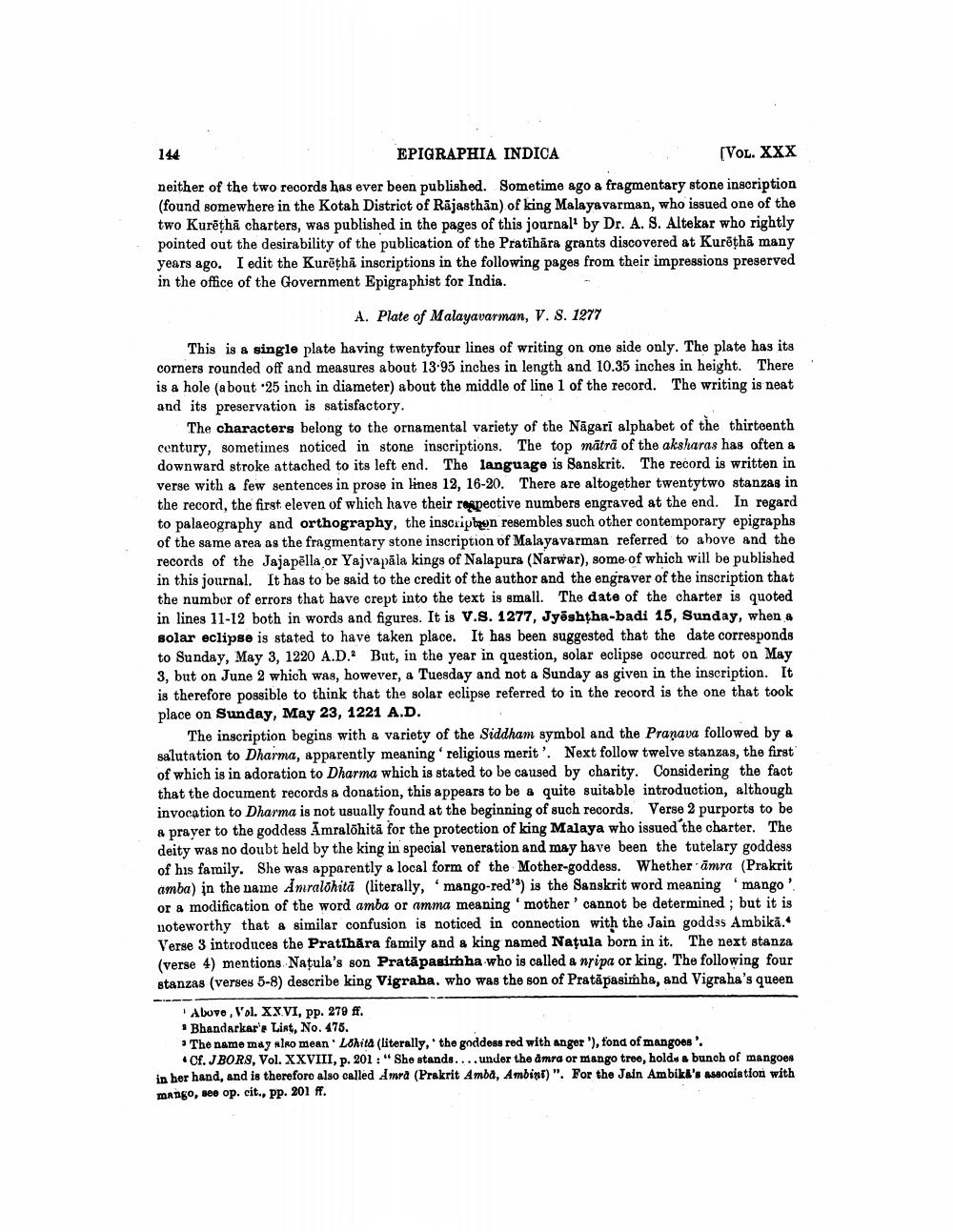________________
144
EPIGRAPHIA INDICA
(Vol. XXX neither of the two records has ever been published. Sometime ago a fragmentary stone inscription (found somewhere in the Kotah District of Rajasthan) of king Malayavarman, who issued one of the two Kurēthā charters, was published in the pages of this journal' by Dr. A. S. Altekar who rightly pointed out the desirability of the publication of the Pratīhāra grants discovered at Kurēthā many years ago. I edit the Kurëtha inscriptions in the following pages from their impressions preserved in the office of the Government Epigraphist for India.
A. Plate of Malayavarman, V. S. 1277
This is a single plate having twentyfour lines of writing on one side only. The plate has its corners rounded off and measures about 13.95 inches in length and 10.35 inches in height. There is a hole (about 25 inch in diameter) about the middle of line 1 of the record. The writing is neat and its preservation is satisfactory.
The characters belong to the ornamental variety of the Nagari alphabet of the thirteenth century, sometimes noticed in stone inscriptions. The top mātrā of the aksharas has often & downward stroke attached to its left end. The language is Sanskrit. The record is written in verse with a few sentences in prose in lines 12, 16-20. There are altogether twentytwo stanzas in the record, the first eleven of which have their respective numbers engraved at the end. In regard to palaeography and orthography, the inscripbon resembles such other contemporary epigraphs of the same area as the fragmentary stone inscription of Malayavarman referred to above and the records of the Jajapēlla or Yajvapāla kings of Nalapura (Narwar), some of which will be published in this journal. It has to be said to the credit of the author and the engraver of the inscription that the number of errors that have crept into the text is small. The date of the charter is quoted in lines 11-12 both in words and figures. It is V.S. 1277, Jyöshtha-badi 15, Sunday, when a solar eclipse is stated to have taken place. It has been suggested that the date corresponds to Sunday, May 3, 1220 A.D. But, in the year in question, solar eclipse occurred not on May 3, but on June 2 which was, however, a Tuesday and not a Sunday as given in the inscription. It is therefore possible to think that the solar eclipse referred to in the record is the one that took place on Sunday, May 23, 1221 A.D.
The inscription begins with a variety of the Siddham symbol and the Pranava followed by a salutation to Dharma, apparently meaning' religious merit'. Next follow twelve stanzas, the first of which is in adoration to Dharma which is stated to be caused by charity. Considering the fact that the document records a donation, this appears to be a quite suitable introduction, although invocation to Dharma is not usually found at the beginning of such records. Verse 2 purports to be & prayer to the goddess Amralohita for the protection of king Malaya who issued the charter. The deity was no doubt held by the king in special veneration and may have been the tutelary goddess of his family. She was apparently a local form of the Mother-goddess. Whether amra (Prakrit amba) in the name Amralõhită (literally, mango-red') is the Sanskrit word meaning 'mango or a modification of the word amba or amma meaning mother' cannot be determined; but it is noteworthy that a similar confusion is noticed in connection with the Jain goddss Ambikā. Verse 3 introduces the Prathāra family and a king named Naţula born in it. The next stanza (verse 4) mentions Natula's son Pratāpasimha who is called a nripa or king. The following four stanzas (verses 5-8) describe king Vigraba, who was the son of Pratāpasimha, and Vigraha's queen
Abovo, Vol. XXVI, pp. 279 ff. Bhandarkar's List, No. 475. • The name may also mean Lohita (literally, the goddess red with anger '), fond of mangoes'.
Cf. J BORS, Vol. XXVIII, p. 201: "She stands.... under the amra or mango tree, holds a bunch of mangoes in her hand, and is therefore also called Amra (Prakrit Amba, Ambint)". For the Jain Ambiki's association with mango, see op. cit., pp. 201 ff.




